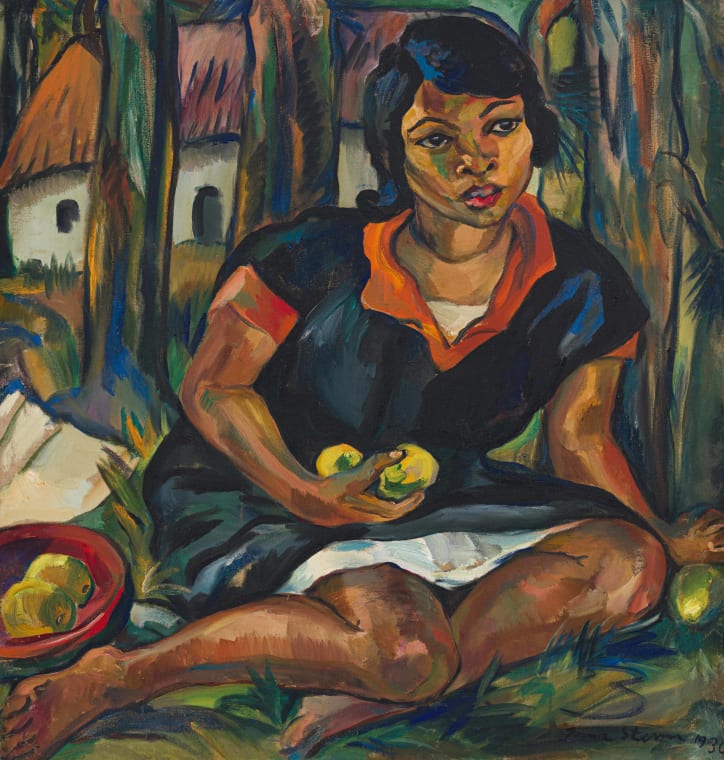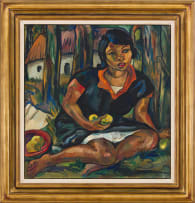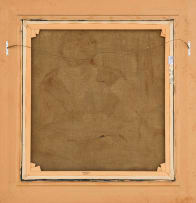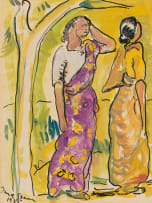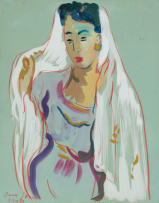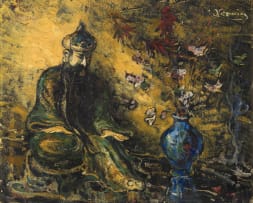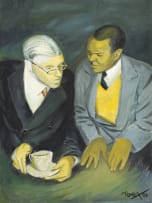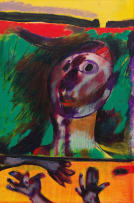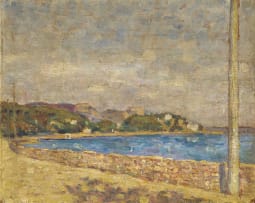Cape Girl with Fruit
Irma Stern
Incl. Buyer's Premium & VAT
About this Item
signed and dated 1930
Notes
Irma Stern was above all a painter of people, an artist motivated by human encounter and its capacity to replenish her creativity. As is clear in this gorgeous portrait of a fashionable young woman seated in a Cape glade, the geography of Stern's encounters mattered too. Art historian Heather Martienssen, writing two years after the painter's death in 1966, honed in on this attribute of Stern's portraiture, stating: 'People and places - people belonging to places - were her constant stimulation.'1 Whether painting in Dakar or Zanzibar, Swaziland or nearer home in the Cape, this balancing act - of situating people in their context - is palpable throughout Stern's finest paintings.
Made during a period of frequent travel across Southern Africa and regular exhibiting in Europe, this important work is notable for both what it shows and how it goes about showing it. The painting depicts an unnamed sitter with bobbed hair in a utilitarian blue dress flecked with Prussian blue. The contrasting collar and cuffs, denoted in orange, are typical of workers' uniforms of the period. Her undergarment, a white slip, is also visible. Notwithstanding a marked tendency in her personal work to depict black and brown people in traditional dress, Stern also allowed the opposite. Her output includes candid portraits of especially Cape Muslim women, an enduring subject throughout her career, in modern garments ranging from casual vests to party dresses and work uniforms.
The setting for this composition, while unspecified, is visibly the Cape. The dwelling behind the seated woman is typical of the modest cottages with thatched roofing erected for descendents of freed slaves in the Bishopscourt, Claremont and Constantia, suburbs close to Stern's home in Rosebank. Examples of these homes were photographed by Arthur Elliott in the decades before Stern's return to Cape Town in 1920.2 The scattering of what appears to be ripening citrus fruit rehearses themes of fertility and labour explored in earlier works from Stern's high-expressionist phase, notably Fruit Carriers (1927) and Swazi Girls with Fruit (1928). But this painting is rendered in an emergent new style. The gratuitous embellishments of Prussian blue are a strong indicator of this new departure.
In the late 1920s, Stern became interested in 'colour theory' and devoted her time to 'studying and building up a new palette.'3 An exhibition of her work in Paris in 1930 further pushed her to reconsider her limited palette and flat surfaces of predictable colours. 'The brown bodies of the natives, with orange, red and green, were domineering colours in her canvases, and this made her think that her palette was limited,' The Star reported on 6 June 1930.4 Produced during a period of stylistic reinvention, when she allowed colour greater agency in describing form and creating texture, this work marks the early beginnings of Stern's celebrated mature style, when the accumulated facets of human encounter were translated into a sensual experience.
The Cezanian fruit form part of this sensual yield. The Constantia Valley, while best known for its grapes, also produced citrus fruits. Groot Constantia was once bordered on each side by orange and lemon trees. While it is possible to intuit details like fashion sensibilities at the Cape during the inter-war years, the living circumstances of Cape Muslims, even Union-period agricultural production from this painting, these things are not what fundamentally motivated Stern as a painter. 'Social reality is of little concern to her,' notes art historian Marion Arnold. 'The immediate visual impression provides the impulse for robustly sensual images which are interpretations, not facsimiles, of life.'5
Stern was a keen observer of art and knowledgeable about art history. The subject of her composition recalls some of the primitivist fancies of Gauguin and Pechstein, as well as the Edenic idylls of Impressionists like Berthe Morisot. The barefooted woman's pose - seated but not submissive - is also redolent of the diminutive woman in the lower right part of Giorgione's The Tempest (c. 1508). In this well-known painting, the facts and living circumstances of 16th century Italy are set in competition with allegory and myth. Two temporalities operate at once. A similar dynamic informs Stern's painting, which provides a sensual approximation - rather than a precise description - of life at the Cape, life not just as it was possibly lived circa 1930, but also how it was imagined by an increasingly liberated painter, Stern.
1 Heather Martienssen (1968) 'The Art of Irma Stern', in Lantern, Vol. 18(2), December. Page 25.
2 Hans Fransen (1993) A Cape Camera: The Architectural Beauty of the Old Cape, Johannesburg, AD Donker & Jonathan Ball. Pages 66-67.
3 Irma Stern, (1933) 'Irma Stern and her Work,' South African Life and the Woman's Forum, Johannesburg, Vol. 1, 7 December.
4 Quoted in Marion Arnold (1995) Marion Arnold (1995) Irma Stern: A Feast for the Eye, Cape Town, Fernwood Press & Rembrandt van Rijn Art Foundation. Page 127.
5 Marion Arnold (1997) Women and Art in South Africa, Cape Town, David Philip. Page 88.
Provenance
Die Kunskamer, Cape Town, 19 March 1979, cat no. 41.
Stephan Welz and Co in Association with Sotheby's, Johannesburg, 8 May 2000, lot 739.
Private Collection.
